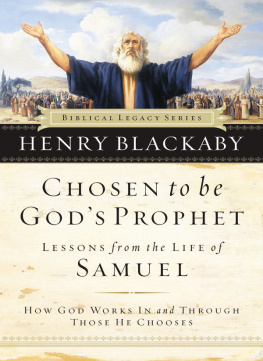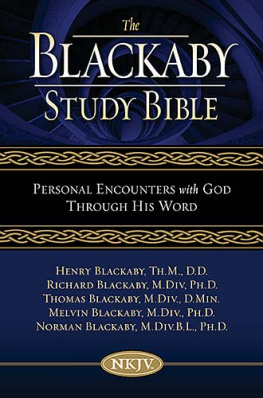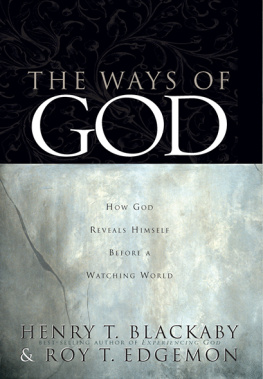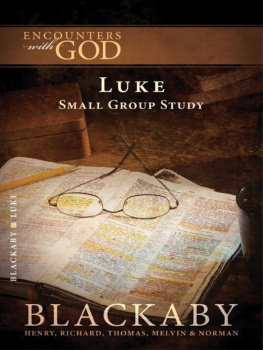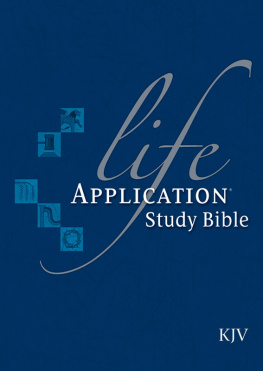Encounters with God
The Second Epistle of Paul
the Apostle to the
CORINTHIANS
Encounters with God Study Guide Series
The Gospel of Matthew
The Gospel of Mark
The Gospel of Luke
The Gospel of John
The Book of Acts
The Book of Romans
The First Epistle of Paul the Apostle to the Corinthians
The Second Epistle of Paul the Apostle to the Corinthians
The Epistle of Paul the Apostle to the Galatians
The Epistle of Paul the Apostle to the Ephesians
The Epistle of Paul the Apostle to the Philippians
The Epistles of Paul the Apostle to the Colossians and Philemon
The First and Second Epistles of Paul the Apostle to the Thessalonians
The First and Second Epistles of Paul the Apostle to Timothy and Titus
The Epistle of Paul the Apostle to the Hebrews
The Epistle of James
The First and Second Epistles of Peter
The First, Second, and Third Epistles of John and Jude
The Revelation of Jesus Christ
Encounters with God
The Second Epistle of Paul
the Apostle to the
CORINTHIANS
Copyright 2008 by
Henry Blackaby, Th.M., D.D.
Richard Blackaby, M.Div., Ph.D.
Thomas Blackaby, M.Div., D.Min.
Melvin Blackaby, M.Div., Ph.D.
Norman Blackaby, M.Div., B.L., Ph.D.
All rights reserved. No portion of this book may be reproduced, stored in a retrieval system, or transmitted in any form or by any meanselectronic, mechanical, photocopy, recording, scanning, or otherexcept for brief quotations in critical reviews or articles, without the prior written permission of the publisher.
Published in Nashville, Tennessee, by Thomas Nelson. Thomas Nelson is a registered trademark of Thomas Nelson, Inc.
Thomas Nelson, Inc. titles may be purchased in bulk for educational, business, fund-raising, or sales promotional use. For information, please e-mail SpecialMarkets@ThomasNelson.com.
All Scripture quotations are taken from THE NEW KING JAMES VERSION. 1982 by Thomas Nelson, Inc. Used by permission. All rights reserved.
ISBN 978-1-4185-2645-0
Printed in the United States of America
08 09 10 11 12 RRD 5 4 3 2 1
CONTENTS
The Lessons:
T he Book of 2 Corinthians is an epistlea formal letter intended to give instruction. The letter was written by the apostle Paul to a vibrant, growing church in the Greek city of Corintha church that Paul had established several years before. The letter is closely linked in content to Pauls epistle known as 1 Corinthians, and it was likely written only a few months after that letter.
The letter that we know as 2 Corinthians was written while Paul was on his third missionary journey. During that third journey, Paul set out to revisit the churches that he had established on his second journey and he wrote to the Corinthians from the road as he traveled in Macedonia, perhaps writing from Philippi or Thessalonica. After writing the letter, Paul continued to travel to the borders of Illyricum and then, as promised in 2 Corinthians, he traveled to Corinth where he spent the winter months of 5657 AD. This was actually Pauls THIRD visit to Corinth.
Paul is writing to people that he knows well, with a number of references to people and events that the people in Corinth knew well. Paul wrote the letter in advance of his personal visit in order that some remaining issues in the Corinthian church might be dealt with prior to his visit.
In truth, Pauls second visit to Corinth had not been pleasant. In 1 Corinthians Paul addressed several doctrinal and ethical problems in the church. He also sent his coworker Timothy to help the Corinthians (1 Corinthians 4:17) but apparently Timothy had not been able to correct the problems. Therefore, Paul had traveled from Ephesus directly to Corintha trip that he considered to be painful (2 Corinthians 2:1)and he returned to Ephesus disheartened, sad, and humiliated. One man had taken the lead in defying Pauls spiritual authority over the congregation.
Once Paul returned to Ephesus, he wrote the Corinthians a strong disciplinary letter and sent it to the church with a coworker named Titus. Paul refers to this document in 2 Corinthians 2:34 and 7:89. (This letter has been lost in history).
Shortly after sending the letter with Titus, Paul embarked on his third missionary journey. He planned to rendezvous with Titus in Troas to learn more about the situation in Corinth (2 Corinthians 2:13). He waited in Troas until the last opportunity for travel across the Aegean before winter storms hit the sea. Then, recognizing that Titus would need to travel by land, he set sail and finally met up with him in Macedonia. Paul received good news about the general condition of the Corinthian church, but also bad news that a small faction continued to oppose his authority and teaching. This situation gave rise to the epistle that we know as 2 Corinthians.
In 2 Corinthians, Paul applauds the actions of the Corinthian church in dealing with those who opposed him and perhaps to vindicate himself further in their eyes, he explains his conduct and defends his own integrity. He reinforces the authenticity of both his apostleship and his message. The result is that 2 Corinthians is the most personal and intimate of all Pauls letters. It has more personal autobiographical references than any other epistle. The tone is loving and gentle for the first seven chapters, but then becomes quite severe as Paul seeks to deal with the remaining opposition in a decisive manner. The letter emphasizes obedience to Christ and respect and submission to Christs messengers. A second strong theme is that of selfless giving, both in Christian service and in the sharing of personal possessions and resources. Paul certainly does not want his third visit with the Corinthians to be like his painful second visitHe longs for the believers there to be fully aware of all Satans ploys and deceptions aimed at splintering the church. His desire is for reconciliation, which Paul contends is made possible as the Holy Spirit helps the Corinthian believers to remain focused on the love of Christ.
About the Author, the Apostle Paul. The author of this book, the apostle Paul, was in a unique position to write a theological letter to both Jewish and Gentile believers in Corinth. Paul, who received the Jewish name Saul at his birth, was born in the Roman city of Tarsus, located in Cilicia (Acts 22:3). A Hebrew by heritage, he grew up in Greek culture and obtained Roman citizenship. His family members, some of whom appear to have been wealthy and socially influential, were citizens of Rome. Saul received the finest education available and was a strong adherent to the Law of Moses. He became a Phariseethe Pharisees were a leading and powerful sect in Judaism. He launched vicious attacks against the followers of Christ and was a witness to Stephens stoning. It was while Saul was in zealous pursuit of the followers of the Way who had gone to Damascus, intending to persecute them even to the point of death, that he was blinded by a supernatural light and heard the voice of Jesus Christ (Acts 9:119). Confronted by Christ Himself, Sauls life was permanently redirected. He became as zealous a messenger for Christ as he once had been a persecutor of Christians. Changing his name to the Greek Paul, he proclaimed Christs Good News to the Gentiles with all-consuming passion, and in his lifetime, he launched at least four missionary journeys to spread the message of salvation and reconciliation with God made possible through Jesus Christs crucifixion and resurrection. It was during his second missionary journey that he established the church in Corinth, spending a year and a half in the city. He was assisted in his ministry there by Silas and Timothy. On his third missionary journey, he also spent a period of weeks, perhaps several winter months, with the Corinthians.
Next page

